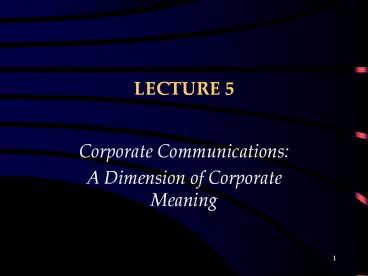Corporate Communications: - PowerPoint PPT Presentation
1 / 21
Title:
Corporate Communications:
Description:
Understanding Common Starting Points (CSPs) and the Sustainable Corporate Story (SCS) ... prolix. 18. One More Time: why are corporate communications important? ... – PowerPoint PPT presentation
Number of Views:4728
Avg rating:3.0/5.0
Title: Corporate Communications:
1
LECTURE 5
- Corporate Communications
- A Dimension of Corporate Meaning
2
Objectives
- Appreciating the complexity of corporate
communications - Understanding Common Starting Points (CSPs) and
the Sustainable Corporate Story (SCS) - MODEL(S) OF THE MOMENTTHE NEW CORPORATE
COMMUNICATIONS WHEEL ANDTHE T W O CORPORATE
COMMUNICATIONS MIXES
3
Marketing and Corporate Communications What are
the differences ?
- MARKETING CORPORATE
- customer
multiple stakeholders - defined set of channels
multiple channels - controlled communication variety
of communication types - positions a product or service
positions an entire -
organisation - more room for creativity less
room for creativity - needs to be consistent with needs
to be consistent with - product/brand attributes
corporate identity/corporate -
brand attributes
4
model of themoment
O
THE NEW CORPORATE COMMUNICATIONS WHEEL
R
N
I
M
V
E
Products/ Services
Advertising
N
N
The
Industry
Direct Marketing and Correspondence
E
Sponsorship
T
Brand
Corporate
NewMedia
Corporate Marketing PR
THECORPORATION
Alliances
Permanent Media
Business
Personal Presentation
Country of Origin
and
T
Partnerships
E
Point of Sale
Impersonal Presentation
N
N
Literature
E
V
M
I
The New Corporate Communications Wheel Balmer
and Greyser. Adapted from D. Bernstein (1984)
R
N
O
The New Corporate Communications Wheel Balmer
and Greyser. Adapted from D. Bernstein (1984) 42
O
The New Corporate Communications Wheel Balmer
and Greyser. Adapted from D. Bernstein (1984) 42
5
Model of the Moment ii (A process for using the
Balmer and Greysers New Corporate Communications
Wheel adapted from Bernstein )
- 1 DEFINE ALL STAKEHOLDER GROUPS
- 2 IDENTIFY COMMUNICATION CHANNELS
- 3 PRIORITISE STAKEHOLDERS
- 4 IDENTIFY APPROPRIATE CHANNELS FOR EACH GROUP
6
Model of the Moment iii
- 5 TAKE ACCOUNT OF THE IMAGE OF COUNTRY OF ORIGIN
and of THE INDUSTRY - 6 additional elements identified by Balmer and
Greyser - TAKE ACCOUNT OF THE CORPORATE BRANDING COVENANT
(where appropriate) - PARTNERSHIP(s) and the effect of ENVIRONMENTAL
FORCES
7
model of the moment iv
- Provides a foundation by which a significant part
of a corporate communications strategy can be
established. - Illustrates the VAST SCOPE of the TASK (comparing
corporate communications to marketing
communications) For instance, 11 stakeholder
groups and 11 channels results in 121
considerations alone!
8
Common Starting Points (CSPs) what are they ?
- An early example of an integrated approach to
corporate communications (developed by Van Riel)
- Rationale to achieve CONSISTENCY in corporate
communications activities by establishing COMMON
STARTING POINTS that underpin ALL FORMAL
corporate communications
9
Common Starting Points continued...
- CSP is an integrated and interdisciplinary
approach taking account of STRATEGY, IDENTITY and
IMAGE. - CSP process representatives from the
corporations various communications departments
establish commonalties (based on the above) which
form the basis of all formal corporate
communications.
10
The Sustainable Corporate Story (SCS)
- What is it? A realistic and relevant description
of key aspects of the organization (origins,
vision and mission) - How is it distinct? It is derived from an
organizations distinctive characteristics (its
identity)
11
The Sustainable Corporate Story....continued
- Perceived Benefits?
- Via communications distinctiveness of message and
consistency of message is achieved.
12
The Sustainable Corporate Story.. continued
- Van Riel suggest that the following should
underpin sustainable corporate stories in that
they should beREALISTIC (based on the
identity)RELEVANT (offer added value elements
for stakeholders) - RESPONSIVE (allows for two way symmetrical
communication) - SUSTAINABLE (needs to meet the sundry demands of
various stakeholder groups)
13
What are the parameters of corporate
communications ?
- Just as there is a marketing mix, services
marketing mix, promotional mix (communication
mix) a number of authors have attempted to
articulate a - CORPORATE COMMUNICATIONS MIX
14
TWO CORPORATE COMMUNICATIONS MIXES
- (a) THE CORPORATE COMMUNICATIONS MIX OF VAN RIEL
- and
- (b) THE TOTAL CORPORATE COMMUNICATIONS MIX OF
BALMER AND GRAY
15
Van Riels Corporate Communication Mix
- Comprises
- Management Communication managers need to
establish a shared vision and trust WITHIN the
organization - Marketing Communication the traditional
marketing communications mix - Organizational Communication communicating to
the various external groups (encompassing a
plethora of corporate-level communications
functions)
16
Balmer and Grays Total Corporate Communications
Mix
- Encompasses
- Primary Communications the communications
effects of products, services, management, staff
and corporate behavior. - Secondary Communications controlled forms of
communications such as advertising and pr - Tertiary Communications word of mouth/spin
17
Finally...
- If the importance of corporate communications
are not understood/managed this can lead to
communications that are - diffuse,
- confusing,
- contradictory and sometimes
- prolix.
18
One More Time why are corporate communications
important?
- Bernstein (1984) argues that
- many business failures are caused by poor
corporate communications. - many businesses lack a clear, overarching,
corporate communications platform - managers NEED to communicate to internal and
external groups - fragmentation across communication disciplines
(pr, advertising, print, investor relations)
causes many difficulties.
19
Summary i
- Corporate Communications is broader, and more
complicated than marketing communications. - It is complicated because of the existence of
multiple channels of communication in addition to
multiple stakeholder groups. - Moreover, individuals invariably belong to
multiple stakeholder groups. - Common Starting Points/the Sustainable Corporate
Story are two routes by which organizations may
achieve consistency in their communications.
20
Summary ii
- Van Riels Corporate Communication Mix and Balmer
and Grays Total Corporate Communications Mix
afford two contrasting perspectives on the area. - The New Corporate Communications Wheel (Balmer
and Greyser) affords a framework for prioritising
stakeholder groups and channels and takes account
of other important factors such as corporate
brand, country of origin, and industry image.
21
Seek first to understand, then to be understood.
- Stephen Covey































